Bichop R.H. (Ed.) Mechatronic Systems, Sensors, and Actuators: Fundamentals and Modeling
Подождите немного. Документ загружается.

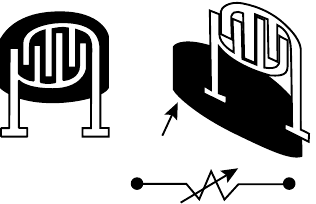
20-44 Mechatronic Systems, Sensors, and Actuators
A capacitance sensor consists of two metal plates separated by an air gap. The capacitance C between
terminals is given by the expression:
(20.57)
where
C = capacitance in farads (F)
ε
o
= dielectric constant of free space
ε
r
= relative dielectric constant of the insulator
A = overlapping area for the two plates
h = thickness of the gap between the two plates
The sensitivity of capacitance-type sensors is inherently low. Theoretically, decreasing the gap h should
increase the sensitivity; however, there are practical electrical and mechanical conditions that preclude
high sensitivities. One of the main advantages of the capacitive transducer is that moving of one of its
plates relative to the other requires an extremely small force to be applied. A second advantage is stability
and the sensitivity of the sensor is not influenced by pressure or temperature of the environment.
20.3.3.4 Force Sensing Resistors (Conductive Polymers)
Force sensing resistors (FSRs) utilize the fact that certain polymer thick-film devices exhibit decreasing
resistance with the increase of an applied force. A force sensing resistor is made up of two parts. The
first is a resistive material applied to a film. The second is a set of digitating contacts applied to another
film. Figure 20.40 shows this configuration. The resistive material completes the electrical circuit between
the two sets of conductors on the other film. When a force is applied to this sensor, a better connection
is made between the contacts; hence, the conductivity is increased. Over a wide range of forces, it turns
out that the conductivity is approximately a linear function of force. Figure 20.41 shows the resistance
of the sensor as a function of force. It is important to note that there are three possible regions for the
sensor to operate. The first abrupt transition occurs somewhere in the vicinity of 10 g of force. In this
region, the resistance changes very rapidly. This behavior is useful when one is designing switches using
force sensing resistors.
FSRs should not be used for accurate measurements of force because sensor parts may exhibit 15–25%
variation in resistance between each other. However, FSRs exhibit little hysteresis and are considered far less
costly than other sensing devices. Compared to piezofilm, the FSR is far less sensitive to vibration and heat.
20.3.3.5 Magnetoresistive Force Sensors
The principle of magnetoresistive force sensors is based on the fact that metals, when cooled to low
temperatures, show a change of resistivity when subjected to an applied magnetic field. Bismuth, in
particular, is quite sensitive in this respect. In practice, these devices are severely limited because of their
high sensitivity to ambient temperature changes.
FIGURE 20.40 Diagram of a typical force sensing resistor (FSR).
C
ε
o
ε
r
A
h
---
=
Resistive Film
A
A
B
B
f
9258_C020.fm Page 44 Tuesday, October 9, 2007 9:08 PM
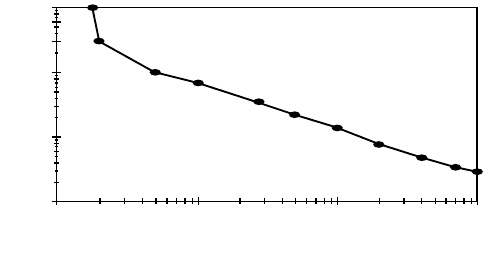
Sensors 20-45
20.3.3.6 Magnetoelastic Force Sensors
Magnetoelastic transducer devices operate based on the Joule effect, that is, a ferromagnetic material is
dimensionally altered when subjected to a magnetic field. The principle of operation is as follows: Initially,
a current pulse is applied to the conductor within the waveguide. This sets up a magnetic field circumference-
wise around the waveguide over its entire length. There is another magnetic field generated by the
permanent magnet that exists only where the magnet is located. This field has a longitudinal component.
These two fields join vectorally to form a helical field near the magnet which, in turn, causes the waveguide
to experience a minute torsional strain or twist only at the location of the magnet. This twist effect is
known as the Wiedemann effect [8].
Magnetoelastic force transducers have a high frequency response (on the order of 20 kHz). Some of
the materials that exhibit magnetoelastic include Monel metal, Permalloy, Cekas, Alfer, and a number of
nickel–iron alloys. Disadvantages of these transducers include: (1) the fact that excessive stress and aging
may cause permanent changes, (2) zero drift and sensitivity changes due to temperature sensitivity, and
(3) hysteresis errors.
20.3.3.7 Torsional Balances
Balancing devices that utilize the deflection of a spring may also be used to determine forces. Torsional
balances are equal arm-scale-force measuring devices. They are comprised of horizontal steel bands instead
of pivots and bearings. The principle of operation is based on force application on one of the arms that
will deflect the torsional spring (within its design limits) in proportion to the applied force. This type
of instrument is susceptible to hysteresis and temperature errors and, therefore, is not used for precise
measurements.
Ta ct il e S e ns o rs
Tac ti le s en so rs are usually interpreted as a touch sensing technique. Tactile sensors cannot be considered
as simple touch sensors, where very few discrete force measurements are made. In tactile sensing, a force
“distribution” is measured using a closely spaced array of force sensors.
Tactile sensing is important in both grasping and object identification operations. Grasping an object
must be done in a stable manner so that the object is not allowed to slip or get damaged. Object
identification includes recognizing the shape, location, and orientation of a product, as well as identifying
surface properties and defects. Ideally, these tasks would require two types of sensing [9]:
1. Continuous sensing of contact forces
2. Sensing of the surface deformation profile
These two types of data are generally related through stress–strain relations of the tactile sensor. As a
result, almost continuous variable sensing of tactile forces (the sensing of the tactile deflection profile)
is achieved.
FIGURE 20.41 Resistance as a function of force for a typical force sensing resistor.
100
10
0.1
10 100 1000 10000
1
Force (
g
)
Resistance (k ohms)
9258_C020.fm Page 45 Tuesday, October 9, 2007 9:08 PM
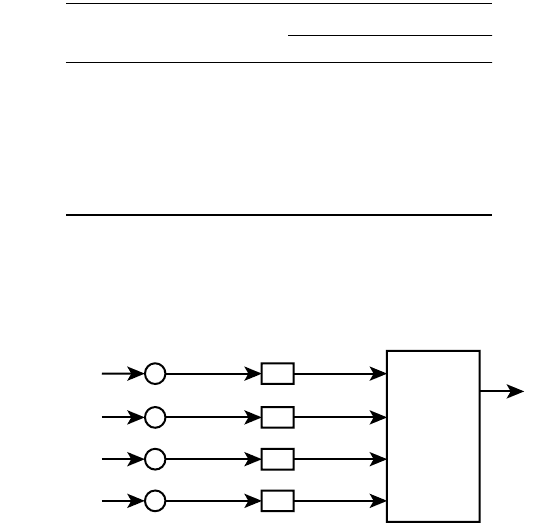
20-46 Mechatronic Systems, Sensors, and Actuators
Tactile Sensor Requirements
Significant advances in tactile sensing are taking place in the robotics area. Applications include automated
inspection of surface profiles, material handling or parts transfer, parts assembly, and parts identification
and gaging in manufacturing applications and fine-manipulation tasks. Some of these applications may
need only simple touch (force–torque) sensing if the parts being grasped are properly oriented and if
adequate information about the process is already available.
Naturally, the main design objective for tactile sensing devices has been to mimic the capabilities of
human fingers [9]. Typical specifications for an industrial tactile sensor include:
1. Spatial resolution of about 2 mm
2. Force resolution (sensitivity) of about 2 g
3. Maximum touch force of about 1 kg
4. Low response time of 5 ms
5. Low hysteresis
6. Durability under extremely difficult working conditions
7. Insensitivity to change in environmental conditions (temperature, dust, humidity, vibration, etc.)
8. Ability to monitor slip
Tac ti le Ar ray Se n sor
Tactile array sensors (Figure 20.42) consist of a regular pattern of sensing elements to measure the
distribution of pressure across the fingertip of a robot. The 8 × 8 array of elements at 2 mm spacing in
each direction provides 64 force sensitive elements. Table 20.2 outlines some of the characteristics of early
tactile array sensors. The sensor is composed of two crossed layers of copper strips separated by strips
of thin silicone rubber. The sensor forms a thin, compliant layer that can be easily attached to a variety
of fingertip shapes and sizes. The entire array is sampled by computer.
TABLE 20.2 Summary of Some of the Characteristics
of Early Tactile Array Sensors
Device Parameter
Size of Array
(4 × 4) (8 × 8) (16 × 16)
Cell spacing (mm) 4.00 2.00 1.00
Zero-pressure capacitance (fF) 6.48 1.62 0.40
Rupture force (N) 18.90 1.88 0.19
Max. linear capacitance (fF) 4.80 1.20 0.30
Max. output voltage (V) 1.20 0.60 0.30
Max. resolution (bit) 9.00 8.00 8.00
Readout (access) time (
µ
s) — <20 —
©IEEE 1985.
FIGURE 20.42 Tactile array sen sor.
Input
(Measurand)
Sensors Preprocessor
Array processor
Output
(Vector)
P
µ
9258_C020.fm Page 46 Tuesday, October 9, 2007 9:08 PM

Sensors 20-47
A typical tactile sensor array can consist of several sensing elements. Each element or taxel
(Figure 20.43) is used to sense the forces present. Since tactile sensors are implemented in applications
where sensitivity providing semblance to human touch is desired, an elastomer is utilized to mimic the
human skin. The elastomer is generally a conductive material whose electrical conductivity changes locally
when pressure is applied. The sensor itself consists of three layers: a protective covering, a sheet of
conductive elastomer, and a printed circuit board. The printed circuit board consists of two rows of two
“bullseyes,” each with conductive inner and outer rings that compromise the taxels of the sensor. The
outer rings are connected together and to a column-select transistor. The inner rings are connected to
diodes (D) in Figure 20.43. Once the column in the array is selected, the current flows through the diodes,
through the elastomer, and thence through a transistor to ground. As such, it is generally not possible
to excite just one taxel because the pressure applied causes a local deformation in neighboring taxels.
This situation is called crosstalk and is eliminated by the diodes [10].
Tactile array sensor signals are used to provide information about the contact kinematics. Several
feature parameters, such as contact location, object shape, and the pressure distribution, can be obtained.
The general layout of a sensor array system can be seen in Figure 20.44. An example of this is a contact
and force sensing finger. This tactile finger has four contact sensors made of piezoelectric polymer strips
on the surface of the fingertip that provide dynamic contact information. A strain gage force sensor
provides static grasp force information.
FIGURE 20.43 Typical taxel sensor array.
FIGURE 20.44 General arrangement of an intelligent sensor array system [9].
Printed circuit board
Elastomer
Protective cover
D
D
D
Parallel
redundancy
2-d Image
l
Line scan
Adder
Voting
system
x
m
n
9258_C020.fm Page 47 Tuesday, October 9, 2007 9:08 PM

20-48 Mechatronic Systems, Sensors, and Actuators
References
1. Shaw, M. C., Metal Cutting Principles, Oxford: Oxford Science Publications, Clarendon Press, 1989.
2. Doebelin, E. O., Measurement Systems, Application and Design, 4th ed., New York: McGraw-Hill,
1990.
3. Dally, J. W., Riley, W. F., and McConnel, K. G., Instrumentation for Engineering Measurements,
New York: John Wiley & Sons, 1984.
4. Mansfield, P. H., Electrical Transducers for Industrial Measurement, London: The Butterworth Group,
1973.
5. Martini, K. H., Multicomponent dynamometers using quartz crystals as sensing elements, ISA Trans.,
22(1), 1983.
6. Spur, G., Al-Badrawy, S. J., and Stirnimann, J., Measuring the Cutting Force in Five-Axis Milling,
Translated paper “Zerpankraftmessung bei der funfachsigen Frasbearbeitung,” Zeitschrift fur
wirtschaftliche Fertigung und Automatisierung 9/93 Carl Hanser, Munchen, Kistler Piezo-
Instrumentation, 20.162e 9.94.
7. Nachtigal, C. L., Instrumentation and Control, Fundamentals and Applications, Wiley Series in
Mechanical Engineering Practice, New York: Wiley Interscience, John Wiley & Sons, 1990.
8. DeSilva, C. W., Control Sensors and Actuators, Englewood Cliffs, NJ: Prentice-Hall, 1989.
9. Gardner, J. W., Microsensors Principles and Applications, New York: John Wiley & Sons, 1995.
10. Stadler, W., Analytical Robotics and Mechatronics, New York: McGraw-Hill, 1995.
Further Information
Wright, C. P., Applied Measurement Engineering, How to Design Effective Mechanical Measurement Systems,
Englewood Cliffs, NJ: Prentice Hall, 1995.
Herceg, E. E., Handbook of Measurement and Control, Pennsauken, NJ: Schavitz Engineering, 1972.
Considine, D. M., Encyclopedia of Instrumentation and Control, New York: McGraw-Hill, 1971.
Norton, H. N., Sensor and Analyzer Handbook, Englewood Cliffs, NJ: Prentice-Hall, 1982.
Sze, S. M., Semiconductor Sensors, New York: John Wiley & Sons, 1994.
Lindberg, B., and Lindstrom, B., Measurements of the segmentation frequency in the chip formation
process, Ann. CIRP, 32(1), 1983.
Tlusty, J., and Andrews, G. C., A critical review of sensors for unmanned machinning, Ann. CIRP, 32(2),
1983.
20.4 Torque and Power Measurement
Ivan J. Garshelis
Torque, speed, and power are the defining mechanical variables associated with the functional perfor-
mance of rotating machinery. The ability to accurately measure these quantities is essential for deter-
mining a machine’s efficiency and for establishing operating regimes that are both safe and conducive
to long and reliable services. Online measurements of these quantities enable real-time control, help
ensure consistency in product quality, and can provide early indications of impending problems.
Torque and power measurements are used in testing advanced designs of new machines and in the
development of new machine components. Torque measurements also provide a well-established basis
for controlling and verifying the tightness of many types of threaded fasteners. This chapter describes
the basic concepts as well as the various methods and apparati in current use for the measurement
of torque and power; the measurement of speed, or more precisely, angular velocity, is discussed
elsewhere [1].
9258_C020.fm Page 48 Tuesday, October 9, 2007 9:08 PM
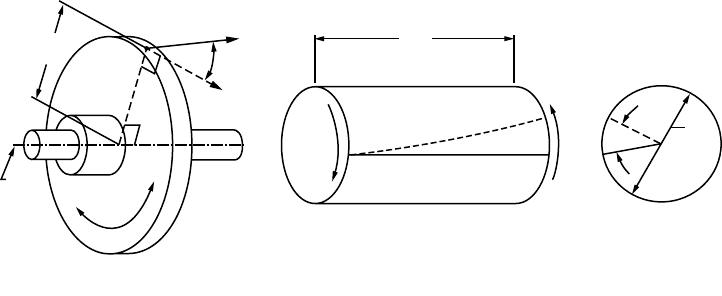
Sensors 20-49
20.4.1 Fundamental Concepts
20.4.1.1 Angular Displacement, Velocity, and Acceleration
The concept of rotational motion is readily formalized: all points within a rotating rigid body move in
parallel or coincident planes while remaining at fixed distances from a line called the axis. In a perfectly
rigid body, all points also remain at fixed distances from each other. Rotation is perceived as a change
in the angular position of a reference point on the body, i.e., as its angular displacement, ∆
θ
, over some
time interval, ∆t. The motion of that point, and therefore of the whole body, is characterized by its
clockwise (CW) or counterclockwise (CCW) direction and by its angular velocity,
ω
= ∆
θ
/∆t. If during
a time interval ∆t, the velocity changes by ∆
ω
, the body is undergoing an angular acceleration,
α
= ∆
ω
/∆t.
With angles measured in radians, and time in seconds, units of
ω
become radians per second (rad s
–1
)
and of
α
, radians per second per second (rad s
–2
). Angular velocity is often referred to as rotational speed
and measured in numbers of complete revolutions per minute (rpm) or per second (rps).
20.4.1.2 Force, Torque, and Equilibrium
Rotational motion, as with motion in general, is controlled by forces in accordance with Newton’s laws.
Because a force directly affects only that component of motion in its line of action, forces or components of
forces acting in any plane that includes the axis produce no tendency for rotation about that axis. Rotation
can be initiated, altered in velocity, or terminated only by a tangential force F
t
acting at a finite radial
distance l from the axis. The effectiveness of such forces increases with both F
t
and l; hence, their product,
called a moment, is the activating quantity for rotational motion. A moment about the rotational axis
constitutes a torque. Figure 20.45(a) shows a force F acting at an angle
β
to the tangent at a point P,
distant l (the moment arm) from the axis. The torque T is found from the tangential component of F as
(20.58)
The combined effect, known as the resultant, of any number of torques acting at different locations along
a body is found from their algebraic sum, wherein torques tending to cause rotation in CW and CCW
directions are assigned opposite signs. Forces, hence torques, arise from physical contact with other solid
bodies, motional interaction with fluids, or via gravitational (including inertial), electric, or magnetic
force fields. The source of each such torque is subjected to an equal, but oppositely directed, reaction
torque. With force measured in newtons and distance in meters, Equation 20.58 shows the unit of torque
to be a Newton meter (Nm).
FIGURE 20.45 (a) The off-axis force F at P produces a torque T = (F cos
β
)l tending to rotate the body in the CW
direction. (b) Transmitting torque T over length L twists the shaft through angle
φ
.
TF
t
lF cos
β
()l==
L
+
O
d
T
T
F
P
I
CCW
CW
β
F
t
b
b'
b'
ba
Axis
(a) (b)
φ
9258_C020_Sec_4-6.fm Page 49 Tuesday, October 9, 2007 9:09 PM
20-50 Mechatronic Systems, Sensors, and Actuators
A nonzero resultant torque will cause the body to undergo a proportional angular acceleration, found,
by application of Newton’s second law, from
(20.59)
where I, having units of kilogram square meter (kg m
2
), is the moment of inertia of the body around
the axis (i.e., its polar moment of inertia). Equation 20.59 is applicable to any body regardless of its
state of motion. When
α
= 0, Equation 20.59 shows that T
r
is also zero; the body is said to be in
equilibrium. For a body to be in equilibrium, there must be either more than one applied torque, or
none at all.
20.4.1.3 Stress, Rigidity, and Strain
Any portion of a rigid body in equilibrium is also in equilibrium; hence, as a condition for equilibrium
of the portion, any torques applied thereto from external sources must be balanced by equal and direc-
tionally opposite internal torques from adjoining portions of the body. Internal torques are transmitted
between adjoining portions by the collective action of stresses over their common cross-sections. In a
solid body having a round cross-section (e.g., a typical shaft), the shear stress
τ
varies linearly from zero
at the axis to a maximum value at the surface. The shear stress,
τ
m
, at the surface of a shaft of diameter,
d, transmitting a torque, T, is found from
(20.60)
Real materials are not perfectly rigid but have instead a modulus of rigidity, G, which expresses the
finite ratio between
τ
and shear strain,
γ
. The maximum strain in a solid round shaft therefore also exists
at its surface and can be found from
(20.61)
Figure 20.45b shows the manifestation of shear strain as an angular displacement between axially
separated cross sections. Over the length L, the solid round shaft shown will be twisted by the torque
through an angle
φ
found from
(20.62)
20.4.1.4 Work, Energy, and Power
If during the time of application of a torque, T, the body rotates through some angle
θ
, mechanical work
(20.63)
is performed. If the torque acts in the same CW or CCW sense as the displacement, the work is said to
be done on the body, or else it is done by the body. Work done on the body causes it to accelerate, thereby
appearing as an increase in kinetic energy (KE = I
ω
2
/2). Work done by the body causes deceleration with
a corresponding decrease in kinetic energy. If the body is not accelerating, any work done on it at one
location must be done by it at another location. Work and energy are each measured in units called a
joule (J). Equation 20.63 shows that 1 J is equivalent to 1 Nm rad, which, since a radian is a dimensionless
ratio, ≡ 1 Nm. To avoid confusion with torque, it is preferable to quantify mechanical work in units of
mN, or better yet, in J.
T
r
I
α
=
τ
m
16T
π
d
3
---------
=
γ
m
τ
m
G
-----
16T
π
d
3
G
-------------
==
φ
32 LT
π
d
4
G
--------------=
WT
θ
=
9258_C020_Sec_4-6.fm Page 50 Tuesday, October 9, 2007 9:09 PM
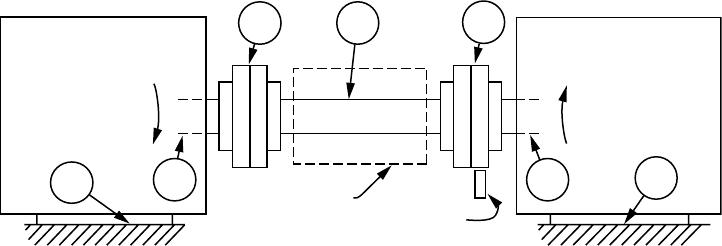
Sensors 20-51
The rate at which work is performed is termed power, P. If a torque T acts over a small interval of time
∆t, during which there is an angular displacement ∆
θ
, work equal to T∆
θ
is performed at the rate T∆
θ
/∆t.
Replacing ∆
θ
/∆t by
ω
, power is found simply as
(20.64)
The unit of power follows from its definition and is given the special name watt (W). 1 W = 1 J s
–1
=
1 mN s
–1
. Historically, power has also been measured in horsepower (Hp), where 1 Hp = 746 W. Rotating
bodies effectively transmit power between locations where torques from external sources are applied.
20.4.2 Arrangements of Apparatus for Torque and Power Measurement
Equations 20.58 through 20.64 express the physical bases for torque and power measurement. Figure
20.46 illustrates a generalized measurement arrangement. The actual apparatus used is selected to fulfill
the specific measurement purposes. In general, a driving torque originating within a device at one location
(B in Figure 20.46) is resisted by an opposing torque developed by a different device at another location
(F). The driving torque (from, e.g., an electric motor, a gasoline engine, a steam turbine, muscular effort,
etc.) is coupled through connecting members C, transmitting region D, and additional couplings, E, to
the driven device (an electric generator, a pump, a machine tool, mated threaded fasteners, etc.) within
which the resisting torque is met at F. The torque at B or F is the quantity to be measured. These torques
may be indirectly determined from a correlated physical quantity, for example, an electrical current or
fluid pressure associated with the operation of the driving or driven device, or more directly by measuring
either the reaction torque at A or G, or the transmitted torque through D. It follows from the cause-and-
effect relationship between torque and rotational motion that most interest in transmitted torque will
involve rotating bodies.
To the extent that the frames of the driving and driven devices and their mountings to the “Earth”
are perfectly rigid, the reaction at A will at every instant equal the torque at B, as will the reaction at G
equal the torque at F. Under equilibrium conditions, these equalities are independent of the compliance
of any member. Also under equilibrium conditions, and except for usually minor parasitic torques (due,
e.g., to bearing friction and air drag over rapidly moving surfaces), the driving torque at B will equal the
resisting torque at F.
Reaction torque at A or G is often determined, using Equation 20.58, from measurements of the forces
acting at known distances fixed by the apparatus. Transmitted torque is determined from measure-
ments, on a suitable member within region D, of
τ
m
,
γ
m
, or
φ
and applying Equations 20.60–20.62 (or
analogous expressions for members having other than solid round cross sections [2]). Calibration, the
measurement of the stress, strain, or twist angle resulting from the application of a known torque, makes
it unnecessary to know any details about the member within D. When
α
¦ 0, and is measurable, T may
FIGURE 20.46 Schematic arrangement of devices used for the measurement of torque and power.
Driving device
Driven device
Driving
torque
AB
CD
E
Transmitting
region
Speed
sensor
Resisting
torque
F
G
PT
ω
=
9258_C020_Sec_4-6.fm Page 51 Tuesday, October 9, 2007 9:09 PM
20-52 Mechatronic Systems, Sensors, and Actuators
also be determined from Equation 20.59. Requiring only noninvasive, observational measurements, this
method is especially useful for determining transitory torques; for example those associated with firing
events in multicylinder internal combustion engines [3].
Equations 20.63 and 20.64 are applicable only during rotation because, in the absence of motion, no
work is done and power transfer is zero. Equation 20.63 can be used to determine average torque from
calorimetric measurements of the heat generated (equal to the mechanical work W) during a totalized
number of revolutions (≡
θ
/2
π
). Equation 20.64 is routinely applied in power measurement, wherein T
is determined by methods based on Equations 20.58, 20.60, 20.61, or 20.62, and
ω
is measured by any
suitable means [4].
F, T, and
φ
are sometimes measured by simple mechanical methods. For example, a “torque wrench”
is often used for the controlled tightening of threaded fasteners. In these devices, torque is indicated by
the position of a needle moving over a calibrated scale in response to the elastic deflection of a spring
member, in the simplest case, the bending of the wrench handle [5]. More generally, instruments, variously
called sensors or transducers, are used to convert the desired (torque or speed related) quantity into a
linearly proportional electrical signal. (Force sensors are also known as load cells.) The determination of
P most usually requires multiplication of the two signals from separate sensors of T and
ω
. A transducer,
wherein the amplitude of a single signal proportional to the power being transmitted along a shaft, has
also been described [6].
20.4.3 Torque Transducer Technologies
Various physical interactions serve to convert F,
τ
,
γ
, or
φ
into proportional electrical signals. Each requires
that some axial portion of the shaft be dedicated to the torque sensing function. Figure 20.47 shows
typical features of sensing regions for four sensing technologies in present use.
20.4.3.1 Surface Strain
Figure 20.47a illustrates a sensing region configured to convert surface strain (
γ
m
) into an electrical signal
proportional to the transmitted torque. Surface strain became the key basis for measuring both force
and torque following the invention of bonded wire strain gages by E. E. Simmons, Jr. and Arthur C. Ruge
in 1938 [7]. A modern strain gage consists simply of an elongated electrical conductor, generally formed
in a serpentine pattern in a very thin foil or film, bonded to a thin insulating carrier. The carrier is
attached, usually with an adhesive, to the surface of the load carrying member. Strain is sensed as a
change in gage resistance. These changes are generally too small to be accurately measured directly and
so it is common to employ two to four gages arranged in a Wheatstone bridge circuit. Independence
from axial and bending loads as well as from temperature variations are obtained by using a four-gage
bridge comprised of two diametrically opposite pairs of matched strain gages, each aligned along a
principal strain direction. In round shafts (and other shapes used to transmit torque), tensile and com-
pressive principal strains occur at 45° angles to the axis. Limiting strains, as determined from
Equation 20.61 (with
τ
m
equal to the shear proportional limit of the shaft material), rarely exceed a few
parts in 10
3
. Typical practice is to increase the compliance of the sensing region (e.g., by reducing its
diameter or with hollow or specially shaped sections) in order to attain the limiting strain at the highest
value of the torque to be measured. This maximizes the measurement sensitivity.
20.4.3.2 Twist Angle
If the shaft is slender enough (e.g., L > 5 d),
φ
, at limiting values of
τ
m
for typical shaft materials, can
exceed 1°, enough to be resolved with sufficient accuracy for practical torque measurements (
φ
at
τ
m
can be found by manipulating Equations 20.60–20.62). Figure 20.47(b) shows a common arrangement
wherein torque is determined from the difference in tooth-space phasing between two identical “toothed”
wheels attached at opposite ends of a compliant “torsion bar.” The phase displacement of the periodic
electrical signals from the two “pickups” is proportional to the peripheral displacement of salient features
on the two wheels, and hence to the twist angle of the torsion bar and thus to the torque. These features
are chosen to be sensible by any of a variety of noncontacting magnetic, optical, or capacitive techniques.
9258_C020_Sec_4-6.fm Page 52 Tuesday, October 9, 2007 9:09 PM
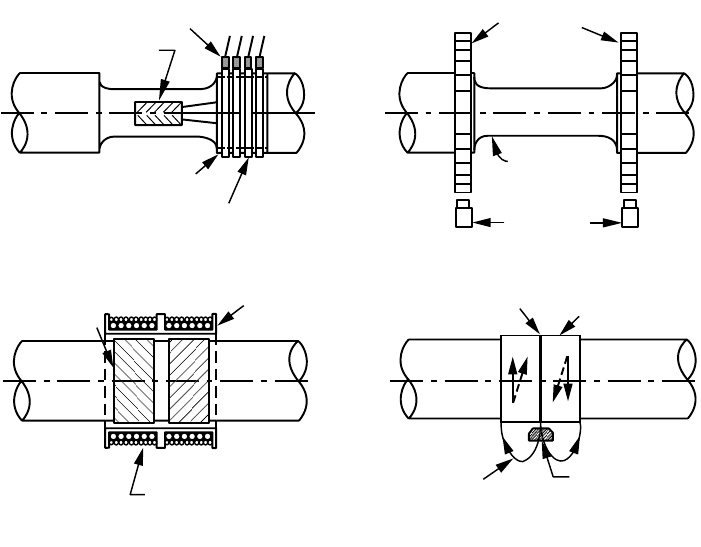
Sensors 20-53
With more elaborate pickups, the relative angular position of the two wheels appears as the amplitude
of a single electrical signal, thus providing for the measurement of torque even on a stationary shaft (e.g.,
[13–15]). In still other constructions, a shaft-mounted variable displacement transformer or a related
type of electrical device is used to provide speed independent output signals proportional to
φ
.
20.4.3.3 Stress
In addition to elastic strain, the stresses by which torque is transmitted are manifested by changes in the
magnetic properties of ferromagnetic shaft materials. This “magnetoelastic interaction” [8] provides an
inherently noncontacting basis for measuring torque. Two types of magnetoelastic (sometimes called
magnetostrictive) torque transducers are in present use: Type 1 derive output signals from torque-induced
variations in magnetic circuit permeances; Type 2 create a magnetic field in response to torque. Type 1
transducers typically employ “branch,” “cross,” or “solenoidal” constructions [9]. In branch and cross
designs, torque is detected as an imbalance in the permeabilities along orthogonal 45° helical paths (the
principal stress directions) on the shaft surface or on the surface of an ad hoc material attached to the
shaft. In solenoidal constructions torque is detected by differences in the axial permeabilities of two
adjacent surface regions, preendowed with symmetrical magnetic “easy” axes (typically along the 45°
principal stress directions). While branch and cross-type sensors are readily miniaturized [10], local
FIGURE 20.47 Four techniques in present use for measuring transmitted torque. (a) Torsional strain in the shaft
alters the electrical resistance for four strain gages (two not seen) connected in a Wheatstone bridge circuit. In
the embodiment shown, electrical connections are made to the bridge through slip rings and brushes. (b) Twist
of the torsion section causes angular displacement of the surface features on the toothed wheels. This creates a
phase difference in the signals from the two pickups. (c) The permeabilities of the two grooved regions of the
shaft change oppositely with torsional stress. This is sensed as a difference in the output voltages of the two sense
windings. (d) Torsional stress causes the initially circumferential magnetizations in the ring (solid arrows) to tilt
(dashed arrows). These helical magnetizations cause magnetic poles to appear at the domain wall and ring ends.
The resulting magnetic field is sensed by the field sensor.
Brushes
Strain gauges
Insulator
To external
circuit
Slip rings
Helical
knurls or
grooves
Coil
bobbin
Excitation
and sense
windings
Toothed
wheels
Torsion
section
Pickups
Domain wall Polarized ring
Magnetic
flux line
Field sensor
(a)
(c) (d)
(b)
9258_C020_Sec_4-6.fm Page 53 Tuesday, October 9, 2007 9:09 PM
